Dometic Group Bundle
How Did Dometic Group Become a Mobile Living Giant?
Ever wondered how a Swedish invention from the 1920s transformed into a global leader in mobile living? The Dometic Group SWOT Analysis reveals a fascinating journey, starting with a revolutionary refrigeration technology. From its humble beginnings, Dometic Group has consistently adapted and expanded, becoming a household name for those who love the open road and the open water.
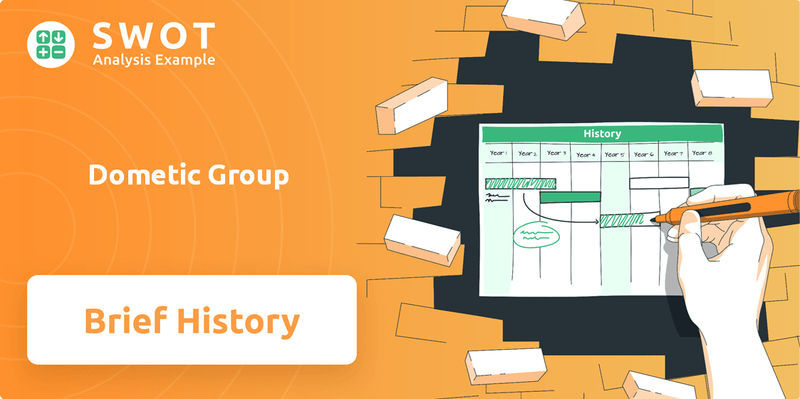
The brief history of Dometic Group showcases an impressive evolution. Initially focused on cooling solutions, the Dometic company strategically expanded its product range and market reach. Understanding the Dometic history is crucial for grasping its current market position and its continued success in the mobile living industry. This journey, marked by key milestones and strategic acquisitions, has solidified Dometic Group's global presence.
What is the Dometic Group Founding Story?
The brief history of Dometic Group begins with a groundbreaking invention in 1922 by Carl Munters and Baltzar von Platen in Sweden. Their innovation, absorption refrigeration technology, set the stage for a company that would become a leader in mobile living solutions. This technology was acquired by Electrolux in 1925, laying the foundation for Dometic's future.
Dometic Group's origins are deeply intertwined with the development of efficient and silent cooling systems. This technology was particularly crucial for environments with limited access to electricity. The company's evolution from Electrolux to an independent entity in 2001 marked a significant milestone in its journey.
The Dometic Group's focus on providing 'domestic' comforts in mobile settings likely influenced its name. The initial funding for Dometic came from its spin-off from Electrolux. The company's early success was influenced by industrial innovation and the growing demand for modern conveniences in the 20th century. Dometic has since expanded to offer a wide range of products for the RV, marine, and commercial vehicle markets, establishing a strong global presence. For a look at how Dometic stands against its rivals, consider reading about the Competitors Landscape of Dometic Group.
Here are some key milestones in the Dometic Group's evolution, highlighting its journey from an innovative technology to a global leader in mobile living solutions.
- 1922: Carl Munters and Baltzar von Platen invent absorption refrigeration technology in Sweden.
- 1925: Electrolux acquires the technology, integrating it into its product line.
- 2001: Dometic Group is spun off from Electrolux, becoming an independent entity.
- Early 2000s-Present: Dometic focuses on expanding its product range and global presence through acquisitions and strategic partnerships.
Dometic Group SWOT Analysis
- Complete SWOT Breakdown
- Fully Customizable
- Editable in Excel & Word
- Professional Formatting
- Investor-Ready Format
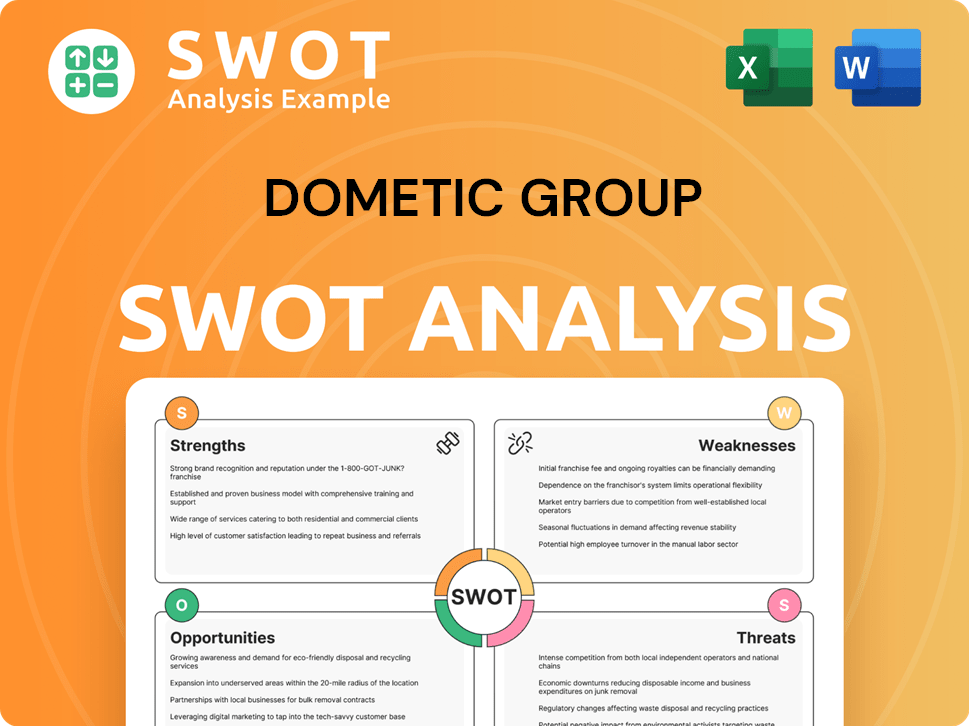
What Drove the Early Growth of Dometic Group?
The early growth and expansion of the Dometic Group, following its 2001 spin-off from Electrolux, marked a strategic shift towards the mobile living market. This period was characterized by a focus on acquisitions and diversification beyond its initial cooling solutions. The company quickly expanded its product range to include sanitation, cooking appliances, and power solutions for recreational vehicles, boats, and trucks.
Dometic's early growth strategy heavily relied on acquisitions to broaden its product portfolio and market reach. These acquisitions were crucial in integrating new technologies and brands under the Dometic umbrella. This approach allowed Dometic to offer more comprehensive solutions to its target markets.
Leveraging its existing global distribution network, Dometic expanded its presence in both established and new geographical markets. The demand in the RV and marine sectors significantly drove early sales milestones, with Dometic's innovative products gaining a strong reputation. This expansion was supported by strategic investments in manufacturing and R&D facilities.
The company diversified its product offerings beyond refrigeration. This included sanitation systems, cooking appliances, and power solutions. This move allowed Dometic to cater to a broader range of needs within the mobile living sector. This diversification strategy enhanced its market position.
To support its growing product lines and market reach, Dometic expanded its team and infrastructure. New facilities and offices were established across different continents to support manufacturing, research and development, and sales operations. This growth was fueled by capital raises, including private equity investments.
During this period, Dometic focused on establishing its independent identity as a mobile living solutions provider. The competitive landscape included various niche players, but Dometic's comprehensive offering and established brand reputation helped it gain market share. A key strategic shift involved moving towards a more integrated systems approach, offering complete solutions rather than individual components. For more information about the company's values, you can read about the Mission, Vision & Core Values of Dometic Group.
Dometic Group PESTLE Analysis
- Covers All 6 PESTLE Categories
- No Research Needed – Save Hours of Work
- Built by Experts, Trusted by Consultants
- Instant Download, Ready to Use
- 100% Editable, Fully Customizable
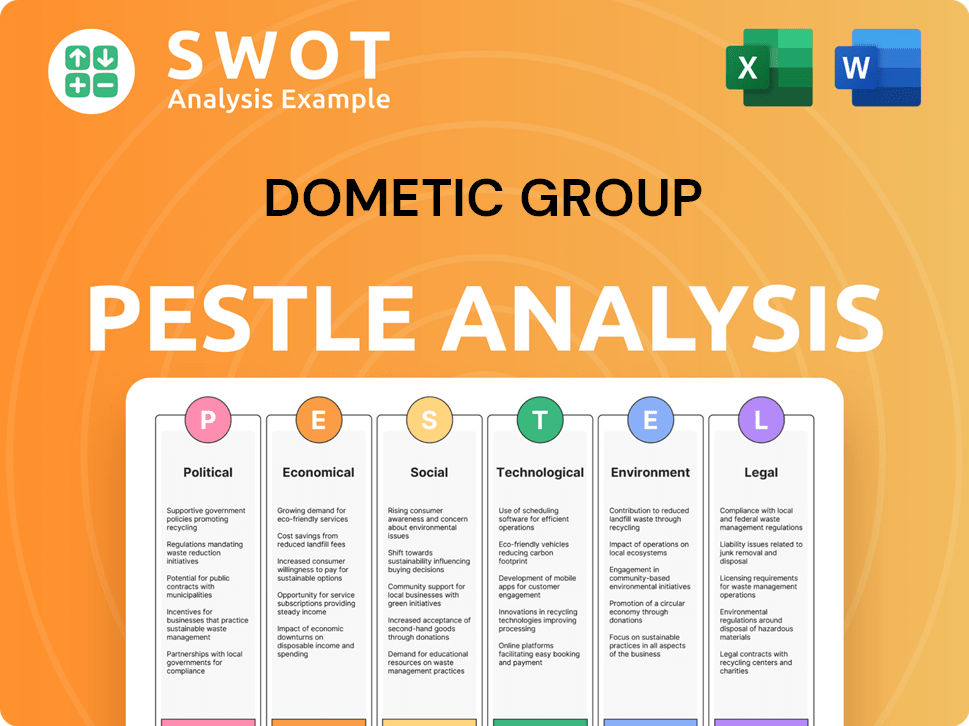
What are the key Milestones in Dometic Group history?
The Dometic Group's journey is marked by significant milestones, reflecting its growth and adaptation within the mobile living industry. From its origins to its current market position, the company has consistently evolved, expanding its product range and global presence.
| Year | Milestone |
|---|---|
| 1920s | The company's roots trace back to the 1920s with the invention of the absorption refrigerator. |
| 1960s | Expansion into the recreational vehicle (RV) market, establishing a strong presence in mobile living solutions. |
| 1990s | Strategic acquisitions and global expansion to broaden its product portfolio and market reach. |
| 2000s | Continued innovation in climate control, sanitation, and cooking solutions for RVs and marine vessels. |
| 2010s | Focus on sustainability and smart technologies, integrating advanced features into Dometic products. |
Dometic Group has consistently introduced innovative products, driving its evolution within the mobile living sector. These innovations have not only improved the user experience but have also set industry standards.
Continuous refinement of absorption refrigeration technology, enhancing energy efficiency and environmental sustainability. This technology remains a core component of Dometic products, especially in the RV and marine sectors.
Development of advanced climate control systems for RVs and marine vessels, offering superior comfort and efficiency. These systems integrate smart technologies for enhanced user control and energy management.
Introduction of integrated cooking solutions, including cooktops, ovens, and grills designed for mobile environments. These solutions prioritize space efficiency and ease of use.
Innovative sanitation systems, including toilets and waste management solutions, designed for RVs and boats. These systems focus on hygiene, water conservation, and ease of maintenance.
Integration of smart technologies into various Dometic products, enabling remote control, monitoring, and enhanced user experience. This includes features like app-based control and data analytics.
Focus on sustainable solutions, including energy-efficient appliances and eco-friendly materials. This aligns with the growing consumer demand for environmentally responsible products.
The
Economic recessions and downturns in the leisure travel market have impacted sales. The company has responded by diversifying its product offerings and expanding into new geographic markets.
Competition from established players and new entrants in various product categories has required continuous innovation and cost management. Dometic Group has focused on product differentiation and customer service.
Disruptions in the global supply chain have necessitated strategic pivots, including optimizing production and sourcing. The company has implemented measures to enhance supply chain resilience.
Product failures, though not extensively publicized, are an inherent risk in manufacturing. Dometic Group has likely addressed these through rigorous quality control and customer feedback mechanisms.
Adapting to changing consumer demands, such as the increasing preference for sustainable and smart mobile living solutions, has required continuous innovation. The company has invested in R&D to meet these evolving needs.
Improving operational efficiency and streamlining its global organization is a constant challenge. Dometic Group has undertaken restructuring initiatives to enhance its operational performance.
Dometic Group Business Model Canvas
- Complete 9-Block Business Model Canvas
- Effortlessly Communicate Your Business Strategy
- Investor-Ready BMC Format
- 100% Editable and Customizable
- Clear and Structured Layout
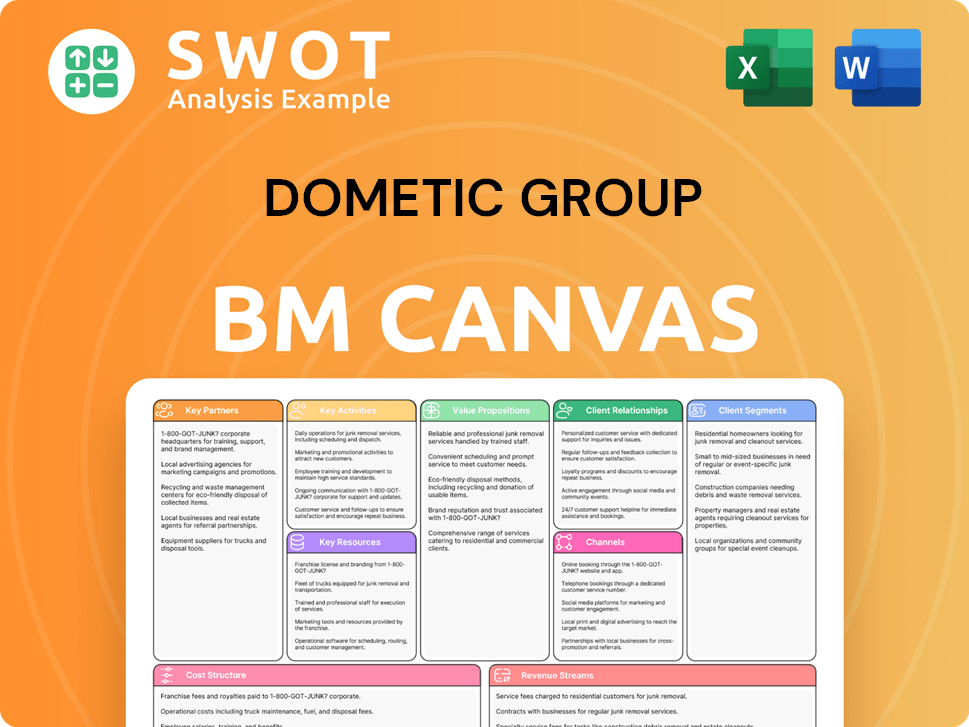
What is the Timeline of Key Events for Dometic Group?
The Marketing Strategy of Dometic Group has been shaped by a series of key events. The journey of the company, previously known as Dometic Group, began in 1922 with the invention of absorption refrigeration. It then evolved through its acquisition by Electrolux in 1925, and later, in 2001, it spun off to become an independent entity. Over time, Dometic Group expanded its product offerings through strategic acquisitions and product development. The company's listing on Nasdaq Stockholm in 2015 marked a significant milestone. The company has navigated challenges, including the global pandemic, and continues to focus on innovation, sustainability, and smart technology integration. These events have shaped the company's position in the mobile living market.
| Year | Key Event |
|---|---|
| 1922 | Carl Munters and Baltzar von Platen invent absorption refrigeration technology, which laid the foundation for future Dometic products. |
| 1925 | Electrolux acquires the absorption refrigeration technology, integrating it into its product lines. |
| 2001 | Dometic Group is spun off from Electrolux, becoming an independent company focused on mobile living solutions. |
| 2015 | Dometic Group is listed on Nasdaq Stockholm, marking a significant step in its corporate development. |
| 2020-2022 | The company navigates the challenges and opportunities presented by the global pandemic, including increased interest in outdoor leisure and mobile living. |
| 2023-2024 | Continued focus on sustainability initiatives, including the development of more energy-efficient products and responsible manufacturing processes. |
Dometic Group is strategically positioned to capitalize on the sustained growth in the outdoor and mobile living sectors. It plans to expand its presence in emerging markets, particularly in Asia and Latin America. The demand for RVs and leisure boats is growing in these regions, creating new opportunities for the company. This expansion is a key part of its long-term strategic initiatives.
The company is committed to an innovation roadmap focused on developing sustainable products, utilizing renewable energy sources, and integrating smart home technologies. Dometic aims to achieve Net Zero emissions in its operations by 2030 and across its value chain by 2050, aligning with global sustainability trends. This is a key part of their future strategy.
Dometic is increasingly focused on integrating smart technology into its products to enhance connectivity and user experience. This includes features that improve the convenience and efficiency of mobile living solutions. The company is responding to the growing demand for connected devices in the RV and marine industries.
The increasing adoption of electric vehicles (EVs) and the rising popularity of glamping and remote work are likely to impact Dometic's future. Analyst predictions suggest continued growth in the global RV and marine markets, benefiting Dometic's core business. The company is well-positioned to capitalize on these trends.
Dometic Group Porter's Five Forces Analysis
- Covers All 5 Competitive Forces in Detail
- Structured for Consultants, Students, and Founders
- 100% Editable in Microsoft Word & Excel
- Instant Digital Download – Use Immediately
- Compatible with Mac & PC – Fully Unlocked
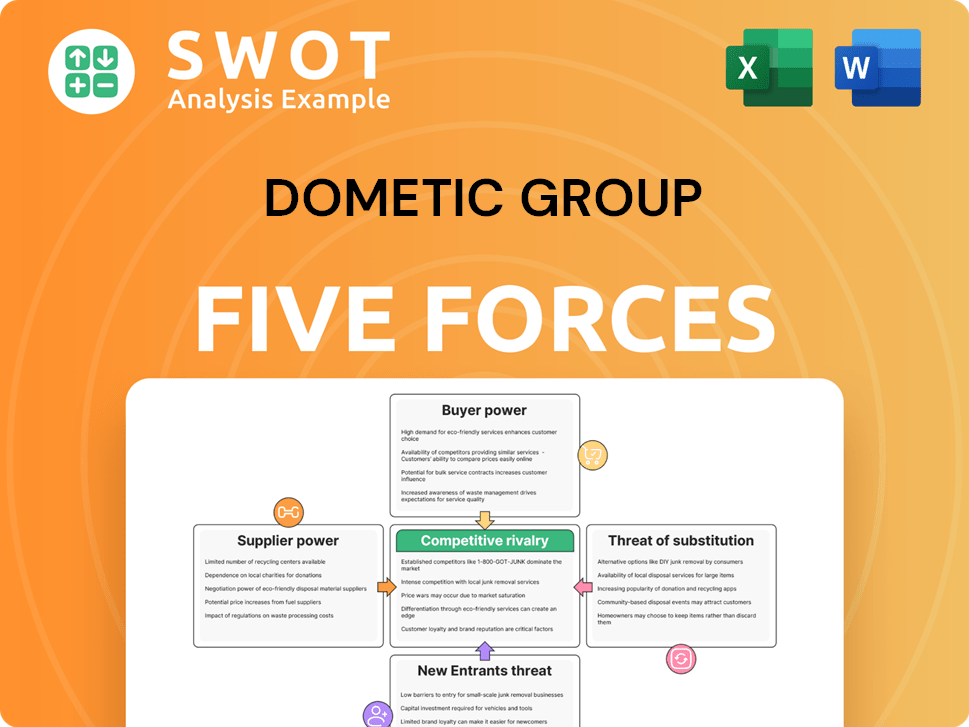
Related Blogs
- What is Competitive Landscape of Dometic Group Company?
- What is Growth Strategy and Future Prospects of Dometic Group Company?
- How Does Dometic Group Company Work?
- What is Sales and Marketing Strategy of Dometic Group Company?
- What is Brief History of Dometic Group Company?
- Who Owns Dometic Group Company?
- What is Customer Demographics and Target Market of Dometic Group Company?
Disclaimer
All information, articles, and product details provided on this website are for general informational and educational purposes only. We do not claim any ownership over, nor do we intend to infringe upon, any trademarks, copyrights, logos, brand names, or other intellectual property mentioned or depicted on this site. Such intellectual property remains the property of its respective owners, and any references here are made solely for identification or informational purposes, without implying any affiliation, endorsement, or partnership.
We make no representations or warranties, express or implied, regarding the accuracy, completeness, or suitability of any content or products presented. Nothing on this website should be construed as legal, tax, investment, financial, medical, or other professional advice. In addition, no part of this site—including articles or product references—constitutes a solicitation, recommendation, endorsement, advertisement, or offer to buy or sell any securities, franchises, or other financial instruments, particularly in jurisdictions where such activity would be unlawful.
All content is of a general nature and may not address the specific circumstances of any individual or entity. It is not a substitute for professional advice or services. Any actions you take based on the information provided here are strictly at your own risk. You accept full responsibility for any decisions or outcomes arising from your use of this website and agree to release us from any liability in connection with your use of, or reliance upon, the content or products found herein.